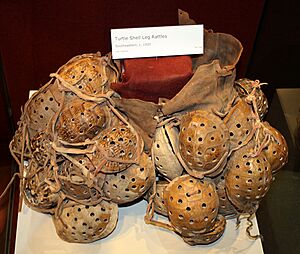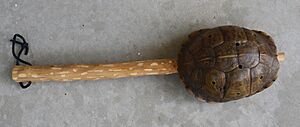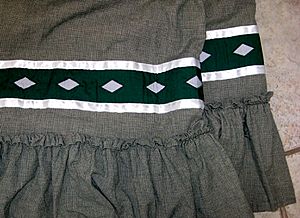Stomp dance facts for kids
The stomp dance is a special dance performed by many Native American tribes in the United States. These tribes include the Muscogee, Yuchi, Cherokee, Chickasaw, Choctaw, Delaware, Miami, Caddo, Tuscarora, Ottawa, Quapaw, Peoria, Shawnee, Seminole, Natchez, and Seneca-Cayuga. Stomp dance communities are active in states like North Carolina, Oklahoma, Alabama, Mississippi, and Florida.

Contents
What is a Stomp Dance?
The English name stomp dance comes from the shuffling and stomping movements of the dancers. In the Muskogee language, it's called opvnkv haco. This means an "inspirited" or "exciting" dance. It describes the energetic and calming feeling the dance gives participants.
The Shawnee language calls it nikanikawe, meaning a dance for friends. Many Shawnees also call it the "leading dance" or simply the "stomp dance." In the Caddo language, it's known as kakiʔtihánnakah.
The Dance Ground and Community
Among Muscogee Creeks and Four Mothers Society members, stomp dance grounds have a special setup. There's a raised square platform with its sides facing the main directions (north, south, east, west). Shelters called arbors are built on these sides. Men sit in these arbors, facing one of the four directions.
This area is called the Square Ground. It's surrounded by a ring of earth. In the middle of the Square Ground is a ceremonial fire. This fire is very important and is often called the "mother" fire. It's seen as a living, sacred being. Songs and prayers focus on this fire.
Outside the Square Ground are the community's clan-houses. These are often called "camps." They can be simple or more developed homes. Before the dance, families prepare dinner in these camps. Guests are always welcome to share the food. Traditional foods include corn bread, mashed potatoes, and special Native American dishes. Some examples are sofkee, pashofa, grape or lye dumplings, and hominy.
Kituwah Cherokee stomp dance grounds have seven clan arbors. This design was inspired by a traditional movement among Cherokees in the late 1800s. By 1907, there were 22 active ceremonial grounds on Cherokee lands in Oklahoma.
Sometimes, stickball games are played at stomp dance grounds. The Yuchi tribe holds their stomp dances with ritual football games. Different tribes often visit and participate in each other's dances, especially in Oklahoma.
Leaders of the Dance

A traditional stomp dance ground is usually led by an older man. In Creek and Seminole traditions, the main leader is called a meko, or "chief." The meko is helped by a second-in-charge called a heniha. There is also a chief medicine man, called a hillis hiya. A speaker, known as meko tvlvswv (the "meko's tongue" or "speaker"), helps the meko. The meko usually doesn't speak to everyone directly, so the speaker does this job.
A traditional Creek ground also has four tvstvnvkes. These are like war chiefs or police. There are also four head ladies and four alternate head ladies.
The Dance Ceremony
A night of dancing usually begins after dark and lasts until the sun comes up the next day. There are many rounds of dancing throughout the night. People who are deeply committed to the ceremony might fast after midnight. They also "touch medicine" four times during the night. They are expected to stay awake all night.
The medicine is made from special roots and plants. These are gathered in a ceremonial way by chosen "medicine helpers." The Heles Haya prepares the medicine at dawn on the day of the dance. This medicine is for the physical and spiritual well-being of the dancers.
One man in the community calls out each song leader and all other participants to dance. Each round is led by a chosen man. He uses his own sequence of songs. These songs come from many traditional rhythms, melodies, and words. Sometimes, he adds his own personal touches. The songs are usually sung in a call-and-response style, in the native language.
Every dance must have at least one woman with shakers. She steps in right behind the song leader to keep the rhythm. The other dancers follow, alternating between men and women. They form a continuous spiral around the central fire. Visitors, young children, and those who are new to the dance usually join at the end.
The dancers move around the fire in a counterclockwise direction. They use strong stomping steps that match the rhythm made by the women's shell shakers. The number of dancers can range from less than ten to several hundred. This depends on the community's size and how many visitors are there.
A round of dancing usually continues until the leader finishes at least four songs. Then, everyone goes back to their seats. They wait until another singer is called to "lead out." There are usually short breaks between leaders. The stomp dance is not meant to be overly difficult. Most participants on the grounds will dance for much of the night.
Where Stomp Dances Happen
Many ceremonial grounds, or stomp grounds, are still active today. They are found in the southeastern United States and Oklahoma. Many southeastern tribes were forced to move to Oklahoma in the 1800s.
The Stokes Smith Stomp Dance Ground is one of about seven active Cherokee grounds. It's located in a quiet part of the Cherokee Nation tribal lands. The Eastern Band of Cherokee Indians stomp grounds is in Raven's Roost, North Carolina. This is on the Qualla Boundary. The Echota Ceremonial Ground has been in Park Hill, Oklahoma since 2001.
There is one active Tuscarora arbor next to the Tuscarora Nation Longhouse. This is in the rural community of Prospect, North Carolina. The Creek tribe has 16 active ceremonial grounds in northeast Oklahoma today. One is Flat Rock, west of Eufaula. Other active communities include Hossossv Tvlvhvse Ceremonial Ground near Atmore, Alabama. Kvnfvske Etvlwv is in Fountain, Florida. The White Oak Shawnee Tribe also has active grounds.
Music and Sounds
Men sing stomp dance songs in a call-and-answer style. A leader starts a song, and the other men sing the chorus. For some dances, the male leader carries a handheld rattle. These rattles are often made from box turtle shells, gourds, or coconuts.
Women create the main rhythm with shakers worn on their legs. These are traditionally made from turtle shells. However, they can also be made from condensed milk cans. Sometimes, a water drum is used during certain dances. Music experts say that "Stomp dance songs are among the most exciting and dramatic musical styles in Native America."
What Dancers Wear

Most stomp dancers wear comfortable but traditional clothing. People often have special outfits for ceremonies. But because the dance is physical and often done outdoors in warm weather, comfort is very important.
Women wear skirts and blouses that usually have traditional patterns. Men wear blue jeans or slacks and hats. These hats are often cowboy or baseball cap styles. They might have a single eagle, hawk, or crane feather in the hatband. The ribbon shirt is a common ceremonial outfit for both men and women. It's a loose-fitting tunic decorated with ribbons. Cherokee women often wear long cotton skirts with ribbonwork in a rattlesnake pattern.
The women wear tortoise shell shakers, or shackles, on both legs. They usually have six to 12 shakers on each leg. These shakers are hollowed-out tortoise shells. They have holes drilled in them and are filled with small river rocks that make them rattle. Traditional Creek and Seminole shakers are made from terrapin or box turtle shells.
Lydia Sam, a Natchez-Cherokee traditionalist, was the first to dance with tin, condensed milk can leg shackles in the 1920s. Today, many women start with "cans" before getting their own set of shells. Women stomp dancers are often called "shell shakers" or "turtles."
Important Rules and Respect
It's important to know that photography is not allowed at ceremonial dances. These ceremonies are religious. Many participants prefer not to discuss details with visitors who are not part of the tribe. This is especially true for information about the medicine.
Pregnant women do not enter the dance circle at ceremonial grounds. Depending on the specific ground, they may or may not touch the medicine. These rules help keep the ceremonies sacred and respectful for everyone involved.
Other Stomp Dances
Sometimes, stomp dances are performed indoors during the winter. This helps avoid the cold weather. Some communities include stomp dances in pow wows or use them for educational demonstrations.
The Caddo, Delaware, and other Woodland and Southern tribes have social stomp dances. These are not ceremonial. The Choctaw Nation of Oklahoma has non-ceremonial grounds for stomp dances and stickball.
The Chickasaw tribe has a ceremonial stomp dance and stickball ground. However, they do not use medicine there. This is because much of their culture was lost over the years due to American Indian boarding schools. This left few medicine men to prepare the ground. The Chickasaws still dance and keep their traditions alive. They have a dance troupe and host dances four times a year in the summer. They also have the Chickasaw Reunion, a festival that replaced the busk ceremony they held until 1936.

